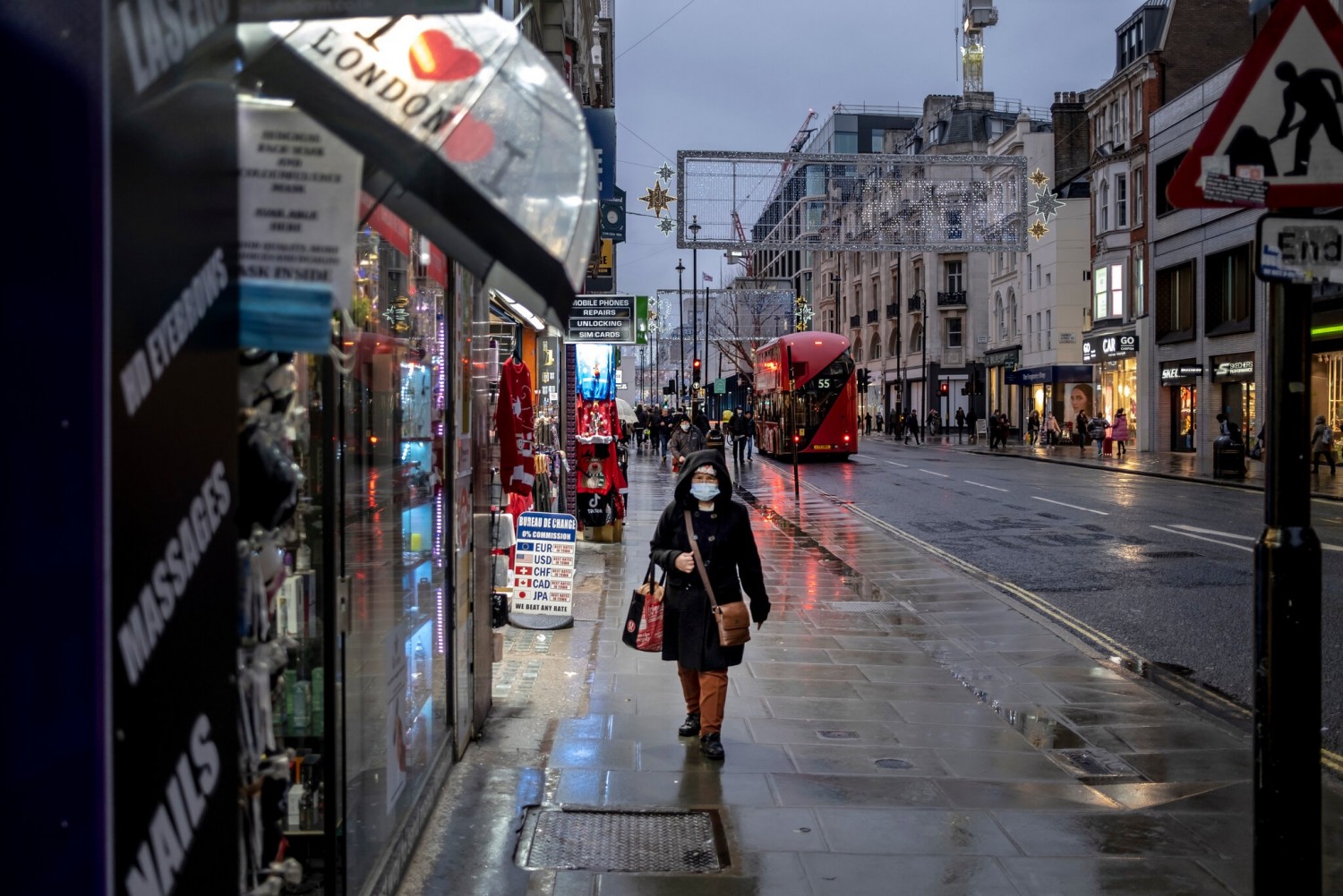
This article is more than
6 year old
Just as vaccines begin to offer hope for a path out of the pandemic, officials in Britain this past weekend sounded an urgent alarm about what they called a highly contagious new variant of the coronavirus circulating in England.
Citing the rapid spread of the virus through London and surrounding areas, Prime Minister Boris Johnson imposed the country’s most stringent lockdown since March. “When the virus changes its method of attack, we must change our method of defense,” he said.
Train stations in London filled with crowds of people scrambling to leave the city as the restrictions went into effect. On Sunday, European countries began closing their borders to travelers from the United Kingdom, hoping to shut out the new iteration of the pathogen.
In South Africa, a similar version of the virus has emerged, sharing one of the mutations seen in the British variant, according to scientists who detected it. That virus has been found in up to 90 percent of the samples whose genetic sequences have been analyzed in South Africa since mid-November.
Scientists are worried about these variants but not surprised by them. Researchers have recorded thousands of tiny modifications in the genetic material of the coronavirus as it has hopscotched across the world.
Some variants become more common in a population simply by luck, not because the changes somehow supercharge the virus. But as it becomes more difficult for the pathogen to survive — because of vaccinations and growing immunity in human populations — researchers also expect the virus to gain useful mutations enabling it to spread more easily or to escape detection by the immune system.
“It’s a real warning that we need to pay closer attention,” said Jesse Bloom, an evolutionary biologist at the Fred Hutchinson Cancer Research Center in Seattle. “Certainly these mutations are going to spread, and, definitely, the scientific community — we need to monitor these mutations and we need to characterize which ones have effects.”
The British variant has about 20 mutations, including several that affect how the virus locks onto human cells and infects them. These mutations may allow the variant to replicate and transmit more efficiently, said Muge Cevik, an infectious disease expert at the University of St. Andrews in Scotland and a scientific adviser to the British government.
But the estimate of greater transmissibility — British officials said the variant was as much as 70 percent more transmissible — is based on modeling and has not been confirmed in lab experiments, Dr. Cevik added.
“Overall, I think we need to have a little bit more experimental data,” she said. “We can’t entirely rule out the fact that some of this transmissibility data might be related to human behavior.”
The mutation affecting antibody susceptibility — technically called the 69-70 deletion, meaning there are missing letters in the genetic code — has been seen at least three times: in Danish minks, in people in Britain and in an immune-suppressed patient who became much less sensitive to convalescent plasma.
“This thing’s transmitting, it’s acquiring, it’s adapting all the time,” said Dr. Ravindra Gupta, a virologist at the University of Cambridge, who last week detailed the deletion’s recurrent emergence and spread. “But people don’t want to hear what we say, which is: This virus will mutate.”
The new genetic deletion changes the spike protein on the surface of the coronavirus, which it needs to infect human cells. Variants of the virus with this deletion arose independently in Thailand and Germany in early 2020, and became prevalent in Denmark and England in August.
Scientists initially thought the new coronavirus was stable and unlikely to escape vaccine-induced immune response, said Dr. Deepti Gurdasani, a clinical epidemiologist at Queen Mary University of London.
“But it’s become very clear over the last several months that mutations can occur,” she said. “As selection pressure increases with mass vaccination, I think these mutants will become more common.”
Several recent papers have shown that the coronavirus can evolve to avoid recognition by a single monoclonal antibody, a cocktail of two antibodies or even convalescent serum given to a specific individual.
Fortunately, the body’s entire immune system is a much more formidable adversary.
The Pfizer-BioNTech and Moderna vaccines induce an immune response only to the spike protein carried by the coronavirus on its surface. But each infected person produces a large, unique and complex repertoire of antibodies to this protein.
“The fact is that you have a thousand big guns pointed at the virus,” said Kartik Chandran, a virologist at the Albert Einstein College of Medicine in New York. “No matter how the virus twists and weaves, it’s not that easy to find a genetic solution that can really combat all these different antibody specificities, not to mention the other arms of the immune response.”
In short: It will be very hard for the coronavirus to escape the body’s defenses, despite the many variations it may adopt.
Escape from immunity requires that a virus accumulate a series of mutations, each allowing the pathogen to erode the effectiveness of the body’s defenses. Some viruses, like influenza, amass those changes relatively quickly. But others, like the measles virus, collect hardly any of the alterations.
Even the influenza virus needs five to seven years to collect enough mutations to escape immune recognition entirely, Dr. Bloom noted. His lab on Friday published a new report showing that common cold coronaviruses also evolve to escape immune detection — but over many years.
The scale of the infections in this pandemic may be quickly generating diversity in the new coronavirus. Still, a vast majority of people worldwide have yet to be infected, and that has made scientists hopeful.
“It would be a little surprising to me if we were seeing active selection for immune escape,” said Emma Hodcroft, a molecular epidemiologist at the University of Bern in Switzerland.
“In a population that’s still mostly naïve, the virus just doesn’t need to do that yet,” she said. “But it’s something we want to watch out for in the long term, especially as we start getting more people vaccinated.”
Immunizing about 60 percent of a population within about a year, and keeping the number of cases down while that happens, will help minimize the chances of the virus mutating significantly, Dr. Hodcroft said.
Still, scientists will need to closely track the evolving virus to spot mutations that may give it an edge over vaccines.
Scientists routinely monitor mutations in flu viruses in order to update vaccines, and should do the same for the coronavirus, said Trevor Bedford, an evolutionary biologist at the Fred Hutchinson Cancer Research Center in Seattle.
“You can imagine a process like exists for the flu vaccine, where you’re swapping in these variants and everyone’s getting their yearly Covid shot,” he said. “I think that’s what generally will be necessary.”
The good news is that the technology used in the Pfizer-BioNTech and Moderna vaccines is much easier to adjust and update than conventional vaccines. The new vaccines also generate a massive immune response, so the coronavirus may need many mutations over years before the vaccines must be tweaked, Dr. Bedford said.
In the meantime, he and other experts said, the Centers for Disease Control and Prevention and other government agencies should set up a national system to link viral sequence databases with on-the-ground data — like whether an infection occurred despite vaccination.
“These are useful pokes for scientists and governments to get systems in place — now, before we might need them, especially as we start vaccinating people,” Dr. Hodcroft said. “But the public should not necessarily be panicking.”
Isabella Kwai contributed reporting from London, and Matina Stevis-Gridneff from Brussels. Sheri Fink contributed reporting from South Africa.